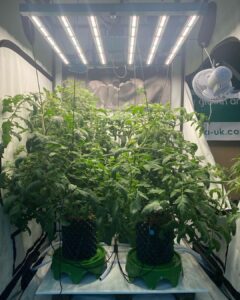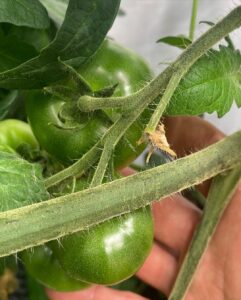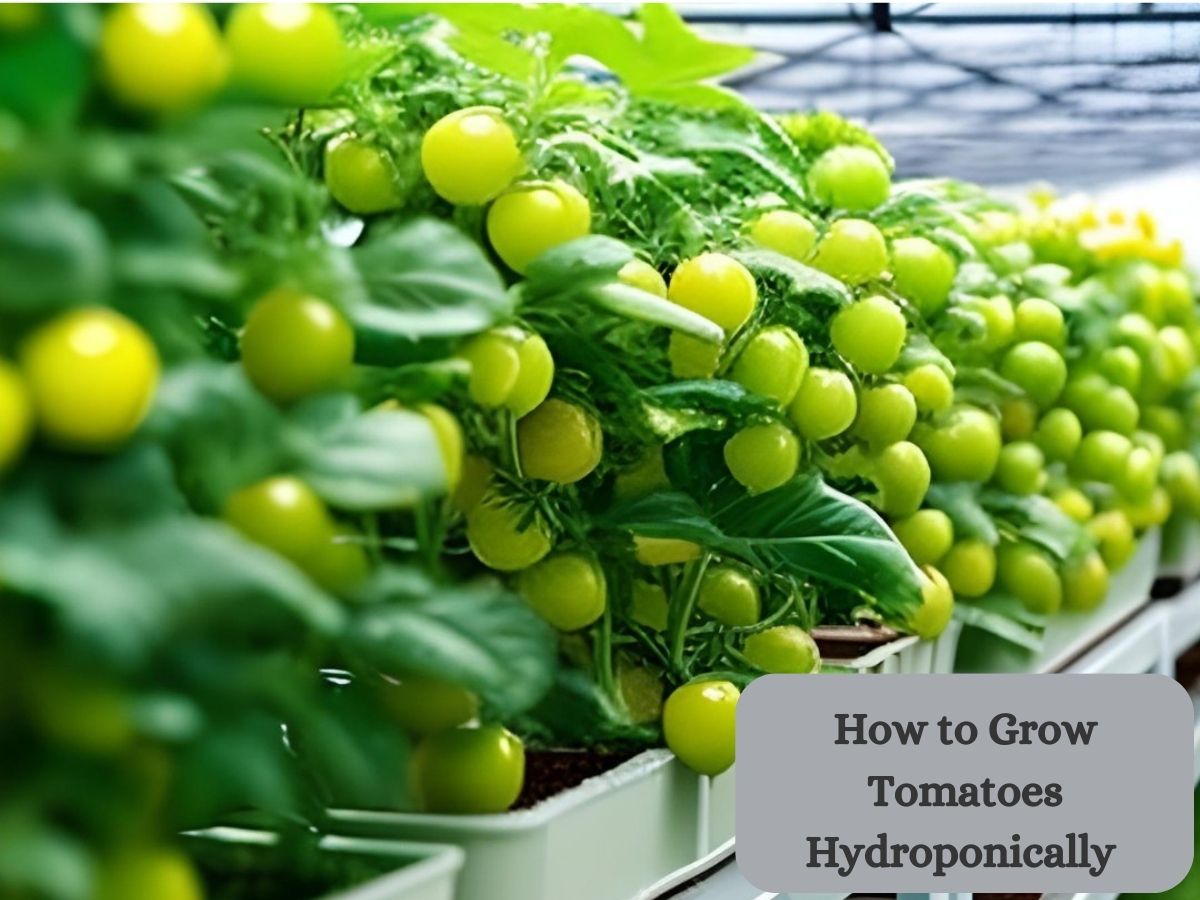How to Grow Tomatoes Hydroponically; If you’re anything like me, the joy of nurturing plants and savoring the delicious fruits of your labor is beyond compare. Today, we’re diving headfirst into the fascinating world of hydroponics, a revolutionary method that promises bumper tomato crops without the need for soil!
Hydroponic tomato cultivation is a revolutionary technique that allows you to grow these luscious fruits without traditional soil. Instead, the plants are nurtured in a nutrient-rich water solution, delivering all the essential minerals directly to their roots.
Say goodbye to weeding, soil-borne pests, and back-breaking labor – this method offers a sustainable and efficient way to cultivate your favorite tomatoes all year round. In this blog, we’ll uncover the secrets to setting up your hydroponic tomato garden, step-by-step.
From choosing the perfect tomato varieties to assembling a simple yet efficient hydroponic system, we’ve got you covered. Forget about weeding, dealing with pests, and soil-borne diseases – with hydroponics, it’s all about harnessing the power of water to witness tomatoes thrive like never before.
Get ready to embark on this thrilling journey into the art and science of growing tomatoes hydroponically.
Getting started with hydroponic gardening
Now that you’re interested in hydroponic gardening, let’s talk about how to get started. The first step in setting up a hydroponic system is to choose the right equipment.
You’ll need a container to hold the nutrient-rich solution, a pump to circulate the solution, an air stone to aerate the solution and grow lights to provide the necessary light for your plants to grow.
You can buy pre-made hydroponic kits or build your system using readily available materials like PVC pipes, buckets, and tubing.
When choosing plants for hydroponic gardening, it’s important to consider the space available and the plant’s growth habits. Tomatoes are an excellent choice for hydroponic gardening, as they are adaptable and easy to grow.
There are several varieties of tomatoes suitable for hydroponics, but you’ll want to choose a determinate variety for smaller spaces or an indeterminate variety for larger areas.
Now, let’s talk about the different types of hydroponic systems. The most common types of hydroponic systems are deep water culture, nutrient film technique, and drip irrigation.
- Deep water culture involves suspending the plants’ roots in nutrient-rich water,
- While the nutrient film technique involves a continuous flow of nutrient solution over the roots.
- Drip irrigation involves delivering nutrient solutions to the roots through drip emitters. For growing tomatoes, the nutrient film technique is the most popular and efficient method.
It allows for the perfect balance of water and nutrients while promoting optimal plant growth. However, all three systems can be used to grow healthy and delicious tomatoes.
Choosing the right tomato variety for hydroponic gardening
Choosing the right tomato variety for hydroponic gardening is critical to the success of your crop. Let’s talk about the characteristics of tomato plants that make them ideal for hydroponic gardening.
Tomatoes are a great choice for hydroponic gardening because they are adaptable and easy to grow. They don’t require a lot of space and can grow in a variety of hydroponic systems. Additionally, tomato plants have a high yield potential and can produce fruit quickly.
When it comes to choosing the right tomato variety for hydroponic gardening, there are several options to consider. Here are some recommended tomato varieties for hydroponic gardening:

- Cherry Tomatoes: Cherry tomatoes are perfect for hydroponic gardening because they grow quickly and produce a lot of fruit. They are also compact, making them ideal for small spaces.
- Roma Tomatoes: Roma tomatoes are another great choice for hydroponic gardening. They are determinate, meaning they grow to a certain size and produce fruit all at once, making them perfect for small hydroponic systems.
- Beefsteak Tomatoes: Beefsteak tomatoes are a larger variety, but they are still suitable for hydroponic gardening. They require a bit more space but can produce large, juicy fruit.
- Heirloom Tomatoes: Heirloom tomatoes are known for their unique flavors and are a great choice for hydroponic gardening. They come in a variety of colors and sizes, making them a popular choice for home gardeners.
- Yellow Pear Tomatoes: Yellow pear tomatoes are a small, sweet variety that is perfect for hydroponic gardening. They produce an abundance of fruit and are a colorful addition to any hydroponic garden.
Planting and growing tomatoes hydroponically
Now that you’ve chosen the right tomato variety for hydroponic gardening, let’s talk about how to plant and grow them in your system. Starting tomato seeds for hydroponic gardening is just like starting them for traditional gardening.
- You’ll want to start by planting your seeds in a seed-starting tray or potting container with a seed-starting mix. Keep the soil moist and warm, and your seeds should germinate in about 7-10 days.
- Once your seedlings have grown to about 2-3 inches tall, you can transplant them into your hydroponic system. To transplant your tomato seedlings, gently remove them from the seed-starting container, being careful not to damage the roots.
- Place them in the hydroponic system, ensuring that the roots are fully submerged in the nutrient-rich solution.
- For optimal growth, tomatoes require specific conditions, such as the right temperature, light, and nutrient levels. Tomatoes thrive in temperatures between 65-85°F (18-30°C), and they require a minimum of 6-8 hours of light each day.
- As for nutrients, tomato plants require a balanced blend of macronutrients and micronutrients, such as nitrogen, phosphorus, potassium, calcium, and magnesium. Ensure that the pH level of the nutrient solution is between 5.5 and 6.5, as this is the ideal range for tomato plants.
To maintain your hydroponic system, it’s essential to monitor the pH level of the nutrient solution regularly. You can use a pH meter or test kit to ensure that the solution is at the optimal level for your plants. Additionally, you’ll want to keep an eye out for pests and diseases that can damage your plants.
Some common hydroponic pests include spider mites, aphids, and whiteflies. To prevent pest infestations, ensure that your system is clean and free of debris. By following these tips, you can ensure that your hydroponic tomato plants thrive and produce a bountiful harvest.

Harvesting and using hydroponic tomatoes
Congratulations, your hydroponic tomato plants are now growing strong and healthy; Now, let’s talk about how to harvest and enjoy your delicious tomatoes. Tomatoes are ripe and ready to harvest when they are fully colored and have a slight give when gently squeezed.
Depending on the variety you’re growing, your tomatoes may take anywhere from 50 to 80 days to reach maturity. When harvesting your tomatoes, be sure to use a sharp pair of scissors or pruning shears to avoid damaging the plant.
Gently twist and pull the tomato from the stem, being careful not to damage any other fruits or stems. Once you’ve harvested your tomatoes, there are countless ways to use them in your favorite dishes. Hydroponic tomatoes are perfect for adding to salads, sandwiches, and pasta dishes.
They’re also great for making homemade sauces, salsas, and ketchup. The flavor of hydroponic tomatoes can be incredibly rich and flavorful, so you may find that you need to use fewer tomatoes in your dishes compared to store-bought tomatoes.
Experiment with different cooking techniques, such as roasting or grilling, to bring out the best flavors in your hydroponic tomatoes. In addition to using your tomatoes in the kitchen, you can also save seeds from your favorite varieties to start new plants in future growing seasons.
Simply scoop out the seeds and pulp from your ripe tomatoes, and rinse them under running water. Allow the seeds to dry completely before storing them in a cool, dry place for future use.
Overall, hydroponic gardening is a fantastic way to grow fresh and flavorful tomatoes right at home. With a little bit of care and attention, you can enjoy a bountiful harvest of delicious tomatoes all year round.
How to Grow Tomatoes Hydroponically FAQs?
What are the benefits of growing tomatoes hydroponically?
Growing tomatoes hydroponically has numerous benefits. Firstly, you can grow them all year round, regardless of the weather outside.
Secondly, hydroponic gardening typically produces higher yields of healthier and tastier tomatoes than traditional soil gardening.
Thirdly, hydroponic systems are more efficient in their use of resources such as water and nutrients, making them an eco-friendly choice.

What are the disadvantages of hydroponic gardening?
One of the main disadvantages of hydroponic gardening is the upfront cost of setting up the system, which can be higher than traditional gardening methods.
Another challenge is the need to monitor and maintain the system regularly to ensure proper nutrient and pH levels. Hydroponic systems also require a source of electricity to run pumps and lighting, which can add to your energy bills.
How much does it cost to set up a hydroponic system for growing tomatoes?
The cost of setting up a hydroponic system for growing tomatoes can vary greatly depending on the size and complexity of the system you choose.
A basic system for growing a few tomato plants can cost as little as $50, while larger, more sophisticated systems can cost several thousand dollars. It’s important to do your research and choose a system that fits your budget and gardening goals.
What are the most common mistakes people make when growing tomatoes hydroponically?
One of the most common mistakes people make when growing tomatoes hydroponically is over or under-fertilizing the plants. It’s important to monitor nutrient levels regularly and adjust them as needed.
Another mistake is not monitoring pH levels, which can cause nutrient lockout and prevent the plants from absorbing the nutrients they need.
It’s also important to choose the right variety of tomato plants for your hydroponic system, as some varieties are better suited for this type of growing than others.
What other plants can be grown hydroponically besides tomatoes?
There are many other plants that can be grown hydroponically besides tomatoes. Some popular options include lettuce, herbs, strawberries, peppers, and cucumbers.
Just like with tomatoes, the benefits of hydroponic gardening for these plants include faster growth, higher yields, and more efficient use of resources.
With a little bit of experimentation, you may find that hydroponic gardening is a great way to grow a variety of fresh and healthy produce right in your own home.
Conclusion
Hydroponic gardening is a fantastic way to grow tomatoes all year round, with many benefits over traditional soil gardening. By setting up a hydroponic system, you can enjoy healthier and tastier tomatoes, higher yields, and more efficient use of resources.
To get started, you’ll need to choose the right equipment and tomato variety and provide the ideal growing conditions. With a little bit of patience and care, you’ll be able to enjoy a bountiful harvest of delicious hydroponic tomatoes in no time.
So why not give it a try? With the right setup and knowledge, anyone can become a successful hydroponic gardener and enjoy fresh, home-grown produce. In conclusion, hydroponic gardening is an excellent option for growing tomatoes at home.
With the right equipment, tomato variety, and growing conditions, you can enjoy fresh and flavorful tomatoes all year round. Hydroponic gardening offers numerous benefits, including faster growth, higher yields, and more efficient use of resources.
By following the steps outlined in this article, you can get started with hydroponic gardening and enjoy a bountiful harvest of delicious tomatoes. So why not give it a try and see for yourself how easy and rewarding it can be to grow your tomatoes hydroponically?
